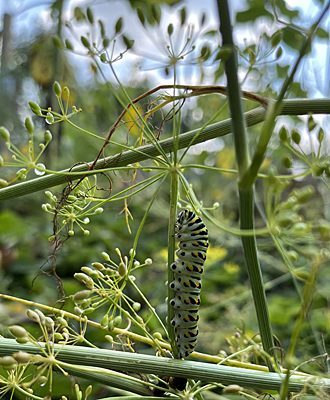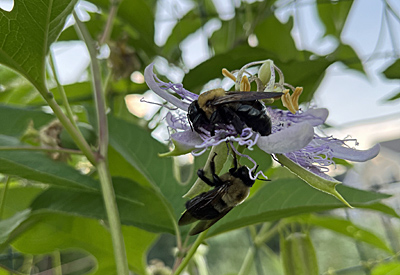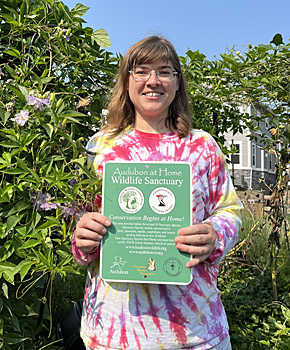by Zuzana Srostlik
My Foraging Roots
My family and I moved here from Europe where local foraging is taken for granted in every park and forest, along every street, and also in every yard. The locally available edibles, including Mirabelle plums, numerous kinds of currants and gooseberries, and all of the good vegetables the millennia of trade with the Far East brought the Europeans were available for the picking. When we moved to the States, we kept this tradition alive in Vermont where we foraged the local mushrooms, berries, and fruit trees, grew a vegetable garden, and foraged wild vegetables too. I firmly believe everyone should be able to identify and eat at least a few of the wild growing species in their area if only to get a little variation in their diet. Where else will you find puffball mushrooms and chicory leaves?
Biodiversity and No Chemicals!

Swallowtail caterpillar on dill.
Photo by Zuzana Srostlik
It might be stressful for some, but the most eco-conscious way to garden is to invite the local predators and prey into your yard. When I first planted my veggie garden here in Virginia, I was horrified by the amount of aphids on my peas, but I was patient. In biodiverse or predator-prey relationship modeling you need to have a large volume of prey before predators can move in and stabilize the relationship. You need both in order to have a healthy ecosystem. After my initial horror, absolutely ALL the ladybugs moved in because I specifically didn’t spray even Neem oil, and now they return year after year. And now I don’t have to personally deal with the aphids and I have extra species of delightful critters in my yard. I also have little toads hopping around in the springtime looking for food. I’m glad I don’t spray chemicals, because the amphibians are the first species to show deformities when harmful chemicals are used.
“Weeds” also have their place. It breaks my heart to see a lawn of only grass covering someone’s entire yard. Instead of paying for systemic herbicides to wipe out the dicots in the spring, and then hiring large tractors to aerate your yard in the fall, thereby spending money not only on the herbicide but also to aerate your yard, you could just leave it to dandelions. If you leave the dandelions to grow, which like growing in compacted dirt, then by their thick substantial roots they will naturally cleave the soil, aerating it as they grow. As an added bonus, their leaves are tasty in salads and sandwiches and their blooms make a fine dandelion wine in the spring.
Native Pawpaws and Maypops
Back to the things I’m encouraging in my yard – I never knew pawpaw trees grow in Virginia before I moved to my house almost three years ago, but once I learned they are native, I needed to get my hands on some! I had cherimoya fruits from the grocery store before which knocked my socks off, and hoped I could grow something of my own from that family of plants. I’m positively delighted to have planted some pawpaw trees and can’t wait to eat my first pawpaw fruit. In my search to find what other “tropical” fruit could grow here, I discovered passion fruits can also grow this far north in the form of our native maypops, which I now have taking over my yard too. The first time I saw them in the wild on a carnivorous plant-finding field expedition, I thought it must have been a volunteer from someone’s dropped lunch and couldn’t imagine a South American tropical plant could also have a North American temperate cousin!

Bees on maypop flower (also known as purple passionflower).
Photo by Zuzana Srostlik
And the natural history of these plants is fascinating too – some of them have natural seed dispersers that are now extinct – like the pawpaw and the wooly mammoths! And when you try to figure out what would eat certain fruits, it makes sense once you realize where they occur in the world. Cacti are New World species, so what’s in the New World that eats cactus fruits? Tortoises and land turtles, of course! Like the tortoises of the Galapagos that eat their native Opuntia cactuses for moisture, our eastern box turtles are also the natural consumers of eastern prickly pear cactus. If you have a good dry habitat for them, you might even encourage turtles to visit your yard.
If you plant native plants, you’ll have less work to do in your yard because they’re acclimated to this environment, the animals that naturally eat them will come visit you, and then those animals’ natural predators will come visit too. The more diverse plants you put in your yard, the more of these relationships you will encourage, and the easier your yard care will be. Since I’m attempting to grow so much, I’m definitely motivated by this fact alone. Tending to pickier plants that don’t belong here just wouldn’t be possible because I just wouldn’t have enough time. I’m delighted by all of the animals that help out in my diversified native plant yard. Those turtles will keep your prickly pears in check so you don’t even have to cut them back. Wildlife, such as foxes, will come to visit pawpaw trees once the fruit drops, which means you might have a nice mouse patrol on site too. When opossums visit, you’ll also have tick patrol.
In my yard, I have both natives and some introduced plants. For the natives, I took the “wait and see what grows if I don’t mow this” approach, and kept the wildflowers, cattails, some native trees and shrubs, and then added in additional native flowers. I’ve had complaints from the neighbors that I stole all the hummingbirds, but I take that as a good sign! I lived in apartments with no yard space for gardening for a decade. Now my home finally has a big yard where I plant natives blended with tasty foods that you just can’t find in good quality in the stores. Herbs like spicy basil may come from Africa, but the little native bees love them, and I will undoubtedly be sharing European gooseberries with the birds. I take a “toss 100 things at the yard and see” approach, making sure they are non-invasive, and try growing as many different things as possible that can grow in our climate. The survivors are many natives, but also hopefully some of the other foods that I want to eat can co-exist. This approach is biodiversity in action! I likely increased the mouse population, but my cellar-hibernating rat snake probably appreciated the meals. A hawk in the area appreciated more mice and snakes to eat. I’m pretty sure the fox is happily living in my homegrown habitat. I use snap traps, not poison, in the house in case of mouse visitors. If a poisoned mouse gets back outside, it will hurt other predators. That is not a chance I am willing to take.
You can tell I take real joy in plants. As Loudoun County increasingly develops, that may enrich the area’s economy, but it makes my heart sad that we are losing the natural ecology, as developments make way for grass monoculture, more pavement, and even more buildings. My yard may look like a mess, but the box turtles sure enjoy the strawberries interwoven with the milkweed for the monarch butterflies and the boneset for all of the bees. The hedge of impassable blackberries that envelops the bottom of the volunteer sumac is formidable, but the flowers are tasty for the bees in the spring and provide blackberry jam for me in the summer. I’m pretty sure that the box turtle eats the blackberries too. I found one hanging out underfoot as I walked through picking the berries earlier in the year. I dropped a few berries for the turtle just in case.
My Property Is Now an Audubon-at-Home Wildlife Sanctuary

Zuzana with her Wildlife Sanctuary sign.
When my neighbors down the street told me they were applying to be a Wildlife Sanctuary and added, “Oh, yeah, for sure your house would qualify because I think all the butterflies here are coming from your yard,” I decided to look into it. I realized I could check all the boxes and mark all of the requirements “met” in a few minutes, so I applied and I’m proud to display the plaque next to my Historical Building designation on my house. It’s nice being recognized for enjoying nature. Not only am I preserving what I can outdoors, but I also have a passion for growing CITES listed (endangered species) plants like tropical carnivorous plants and orchids indoors, and I have a few scraggly-looking temperate pitcher plants in the garden that I hope are helping to keep down the mosquito population! Sarracenia are the native Virginia pitcher plants, so if you’re in a boggy, nutrient-poor area, you might think about installing a pitcher plant bog.
I want there to be more space for these animals and plants, and I also wish for everyone who only has a grass walkway as the natural space around their house to experience as much joy as I do in their surroundings. Just because they weren’t lucky enough to get here before all the good gardening land was gone shouldn’t exclude them from this soul-filling, ecology-improving, healthy and fortifying experience that includes getting to play contortion artist picking blackberries through the thorny bushes, or doing bone-density-building weight-lifting carrying a watering can across their garden, or building community with their neighbors by swapping seeds and growing tips. The local animals are absolutely thriving in my veggie garden too, because foods like squash have been grown for centuries here and the bumblebees positively love them. The maypops have a captive hummingbird moth and carpenter bee audience. And the birds get a buffet of bugs to eat.
Hoping to Make a Difference with a Community Garden
I’ve just started a petition to turn a house for sale in my neighborhood with a large yard into a community allotment garden. As of this writing 94 people have signed the petition, and I’m set to ask Loudoun County and the town of Ashburn this coming Tuesday (October 25, 2022) how to make this possible. Even if it doesn’t turn into exactly my vision, it shows that the people want a garden – something that is more than just a little grass around each house, and I can feel satisfied that I did as much as I could possibly think to do to make a difference. I hope a garden of some kind happens, and you can bet I’m going to advocate for the maximum amount of pawpaw trees possible!

